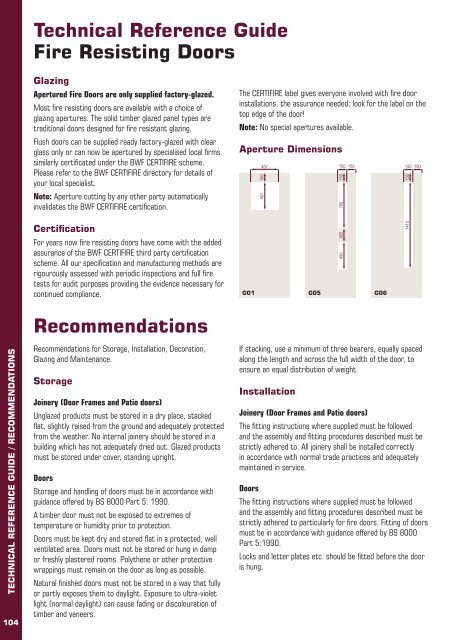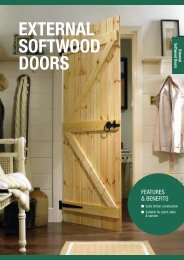DOORS, FLOORING & JOINERY - Benchmarx Kitchens and Joinery
DOORS, FLOORING & JOINERY - Benchmarx Kitchens and Joinery
DOORS, FLOORING & JOINERY - Benchmarx Kitchens and Joinery
You also want an ePaper? Increase the reach of your titles
YUMPU automatically turns print PDFs into web optimized ePapers that Google loves.
Technical Reference Guide<br />
Fire Resisting Doors<br />
Glazing<br />
If the door is preservative treated, any cut or drilled area Doors<br />
Apertured Fire Doors are only supplied factory-glazed.<br />
Most fire resisting doors are available with a choice of<br />
glazing apertures. The solid timber glazed panel types are<br />
traditional doors designed for fire resistant glazing.<br />
Flush doors can be supplied ready factory-glazed with clear<br />
glass only or can now be apertured by specialised local firms<br />
similarly certificated under the BWF CERTIFIRE scheme.<br />
Please refer to the BWF CERTIFIRE directory for details of<br />
The CERTIFIRE label gives everyone involved with fire door<br />
installations, the assurance needed: look for the label on the<br />
top edge of the door!<br />
Note: No special apertures available.<br />
Aperture Dimensions<br />
457<br />
150 150<br />
150 150<br />
for locks <strong>and</strong> letter plates etc., must also be preservative<br />
treated before hanging.<br />
Preparation for <strong>and</strong> installation of any additional hardware<br />
must be effected in a manner that ensures that water cannot<br />
penetrate inside the external protective coating/layer.<br />
A reduction in the width of the door must be achieved by<br />
removing equal amounts from each side of the door.<br />
Feature <strong>and</strong> panel doors should not be reduced by more<br />
Decorate in accordance with the British St<strong>and</strong>ard Code<br />
of Practice BS 6150:1991. Painting of Buildings, <strong>and</strong> BS<br />
8000 Part 12: 1989<br />
The stain or paint manufacturers instructions must be<br />
followed.<br />
All surfaces must be treated (sealed) at the same time to<br />
prevent distortion from moisture imbalance. A base coat<br />
stain or paint primer are in themselves not a seal.<br />
your local specialist.<br />
Note: Aperture cutting by any other party automatically<br />
than 6mm all round. Moulded <strong>and</strong> Flush doors a maximum<br />
of 6mm bottom, <strong>and</strong> 4mm off each long edge.<br />
It is essential that the paint or stain be applied to all four<br />
edges of the door <strong>and</strong> inside all cut-outs for locks, letter<br />
invalidates the BWF CERTIFIRE certification.<br />
Tops of doors are not recommended to be trimmed. plates, hinges <strong>and</strong> glazing recesses.<br />
Fire doors in particular must not be trimmed at the top. We recommend that in areas of severe exposure external<br />
Certification<br />
Care must be taken in the fitting of locks <strong>and</strong> latches to doors should be protected by a porch, hood/canopy, in<br />
For years now fire resisting doors have come with the added<br />
assurance of the BWF CERTIFIRE third party certification<br />
scheme. All our specification <strong>and</strong> manufacturing methods are<br />
rigourously assessed with periodic inspections <strong>and</strong> full fire<br />
ensure that the performance of the stile/rail joints are<br />
in no way impaired. Mortice locks must not be fitted<br />
opposite the midrail because of the danger of removing the<br />
dowels <strong>and</strong> weakening the door.<br />
addition to the recommended decorative protection.<br />
Glazing<br />
tests for audit purposes providing the evidence necessary for<br />
External doors must be hung on 1½ pairs of good quality <strong>Joinery</strong> (Door Frames <strong>and</strong> Patio doors)<br />
continued compliance.<br />
Recommendations<br />
Recommendations for Storage, Installation, Decoration,<br />
Glazing <strong>and</strong> Maintenance.<br />
Storage<br />
<strong>Joinery</strong> (Door Frames <strong>and</strong> Patio doors)<br />
Unglazed products must be stored in a dry place, stacked<br />
G01<br />
G05<br />
G06<br />
If stacking, use a minimum of three bearers, equally spaced<br />
along the length <strong>and</strong> across the full width of the door, to<br />
ensure an equal distribution of weight.<br />
Installation<br />
<strong>Joinery</strong> (Door Frames <strong>and</strong> Patio doors)<br />
brass or steel l02mm (4”) hinges. Internal doors can be<br />
hung on one pair of hinges 76mm (3”) unless the weight<br />
exceeds 20kg or a large difference in humidity on opposite<br />
faces of the door is likely. A bathroom door for example,<br />
requires one <strong>and</strong> a half pairs of hinges.<br />
Jambs <strong>and</strong> stops in door frames must be square <strong>and</strong> plumb.<br />
Special detail attention must be paid to installation of fire<br />
doors, including compatibility of frame, intumescent seals<br />
<strong>and</strong> all hardware <strong>and</strong> ironmongery. Technical data sheets<br />
are available on our website.<br />
Decoration<br />
Glazing must be carried out using a proprietary material<br />
or glazing system complying with the requirements of BS<br />
8000 Part 7: 1990 <strong>and</strong> NHBC St<strong>and</strong>ards Charter 6.7<br />
January 1999 edition effective from January 2000.<br />
Linseed oil putty is not permitted <strong>and</strong> such use will<br />
invalidate the guarantee.<br />
Setting blocks, distance pieces <strong>and</strong> glazing spacers<br />
must be used. See product instructions for details.<br />
Also available on our website. Glazing rebates <strong>and</strong> the<br />
concealed surfaces of all beads must receive either a coat<br />
of proprietary br<strong>and</strong> sealer or two coats of the finishing<br />
material, to be applied to the frame before glazing.<br />
flat, slightly raised from the ground <strong>and</strong> adequately protected<br />
from the weather. No internal joinery should be stored in a<br />
building which has not adequately dried out. Glazed products<br />
must be stored under cover, st<strong>and</strong>ing upright.<br />
Doors<br />
Storage <strong>and</strong> h<strong>and</strong>ling of doors must be in accordance with<br />
guidance offered by BS 8000 Part 5: 1990.<br />
A timber door must not be exposed to extremes of<br />
temperature or humidity prior to protection.<br />
Doors must be kept dry <strong>and</strong> stored flat in a protected, well<br />
ventilated area. Doors must not be stored or hung in damp<br />
or freshly plastered rooms. Polythene or other protective<br />
wrappings must remain on the door as long as possible.<br />
Natural finished doors must not be stored in a way that fully<br />
or partly exposes them to daylight. Exposure to ultra-violet<br />
light (normal daylight) can cause fading or discolouration of<br />
timber <strong>and</strong> veneers.<br />
The fitting instructions where supplied must be followed<br />
<strong>and</strong> the assembly <strong>and</strong> fitting procedures described must be<br />
strictly adhered to. All joinery shall be installed correctly<br />
in accordance with normal trade practices <strong>and</strong> adequately<br />
maintained in service.<br />
Doors<br />
The fitting instructions where supplied must be followed<br />
<strong>and</strong> the assembly <strong>and</strong> fitting procedures described must be<br />
strictly adhered to particularly for fire doors. Fitting of doors<br />
must be in accordance with guidance offered by BS 8000<br />
Part 5:1990.<br />
Locks <strong>and</strong> letter plates etc. should be fitted before the door<br />
is hung.<br />
<strong>Joinery</strong> (Door Frames <strong>and</strong> Patio doors)<br />
All undecorated joinery supplied in the white must be<br />
suitably primed or stained without delay after receipt<br />
<strong>and</strong> all joinery supplied primed must receive further coats<br />
of paint within 6 months of delivery. Knotting must be<br />
reapplied if knots become visible.<br />
<strong>Joinery</strong> supplied with a basecoat of stain must receive<br />
further decorative coats as soon as possible <strong>and</strong> certainly<br />
within 3 months. Knotting treatment must be applied if an<br />
opaque paint finish is required. Any surfaces subsequently<br />
cut, particularly those exposing end grain, must be brush<br />
coated with preservative <strong>and</strong> if required for paint finish<br />
must also be primed before the joinery is fixed in position<br />
in accordance with British St<strong>and</strong>ards or Eurocodes.<br />
St<strong>and</strong>ard insulating glass units used in patio doors <strong>and</strong><br />
conservatories must not be used in areas of high humidity,<br />
e.g. swimming pools or similar.<br />
Further information is contained in the leaflet attached to<br />
each unit.<br />
Maintenance<br />
<strong>Joinery</strong> (Door Frames <strong>and</strong> Patio doors)<br />
The decorative finish applied to external joinery must be<br />
maintained in service <strong>and</strong> moisture must not be allowed to<br />
penetrate into the timber throughout its life.<br />
Annual inspection should be made <strong>and</strong> touching up carried<br />
out as necessary in areas of wear.<br />
104 105<br />
TECHNICAL REFERENCE GUIDE / RECOMMENDATIONS<br />
150<br />
457<br />
150<br />
450 225<br />
760<br />
150<br />
1410<br />
Recommendations<br />
RECOMMENDATIONS



